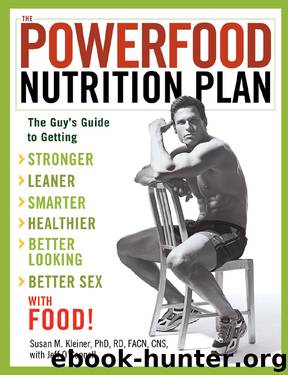The Powerfood Nutrition Plan by Susan Kleiner & Jeff O'Connell

Author:Susan Kleiner & Jeff O'Connell
Language: eng
Format: epub
Publisher: Rodale
Published: 2006-12-30T16:00:00+00:00
The Immune System
There are some problems that hydration alone can’t fix. When it comes to boosting your immune system, food is the way to go.
We’re used to thinking of the immune system in mysterious terms—your body somehow “builds resistance” to a disease or “fights off” the flu. In reality, the immune system is a very real network of cells and molecules whose job is to maintain the well-being of our bodies and kill (or at least isolate) foreign particles, like bacteria, that find their way in. It’s become standard practice today to bolster our immune systems with a barrage of antibiotics and other drugs, a practice that some argue will hurt our immune systems in the long run. One thing is for certain, though: Eat right, and you’ll need antibiotics a whole lot less.
Plenty of foods can kick bacteria’s butt and jump-start your immune system, and I’ll give you the best of them later in this section. But I can’t go any further without making this point:
The number-one way to protect your immune system through food is to just eat.
If you aren’t getting enough calories, your body switches to starvation-adaptation mode. That means it effectively decides to channel calories to body parts that need them most, like your heart and your brain. The flip side is that your body slowly begins to stop feeding the systems that aren’t critical to staying alive at the moment. Your immune system is toward the top of that list. If you have only so much energy to go around, and you have to keep your heart beating and your blood pumping, the immune system is secondary. It’s not critical to staying alive at the moment. That’s why immune function diminishes in people who starve themselves thin. Test their immune function and you won’t get much response.
This doesn’t mean that you can’t be on a weight-loss diet. It means there’s a point at which you won’t have enough critical calories to go around. To help you understand how many calories your body needs, do a simple test.
1. Figure out your Resting Energy Expenditure (REE—the number of calories you would need for survival if your daily routine consisted of nothing more than watching television and sleeping) by multiplying your weight times 11.
2. Use the chart below to pick your Activity Factor (AF—a number that scientists use to represent the amount of activity you do in a day).
3. Multiply your REE times your AF. That is your base number of calories per day, known as your Total Energy Expenditure (TEE).
To maintain your health, I’d recommend straying no more than 300 calories from your daily TEE and definitely no more than 500 calories. For example, a 180-pound guy with an activity factor of 1.7 has a TEE of 3,397. To lose weight, he should eat around 3,097 calories, and he must eat at least 2,897 per day. On the other hand, if he wants to gain muscle, he should eat between 3,697 and 3,897 calories. (If you are
Download
This site does not store any files on its server. We only index and link to content provided by other sites. Please contact the content providers to delete copyright contents if any and email us, we'll remove relevant links or contents immediately.
The Bone Broth Miracle: How an Ancient Remedy Can Improve Health, Fight Aging, and Boost Beauty by Ariane Resnick(16553)
How to Be a Bawse: A Guide to Conquering Life by Lilly Singh(7391)
The Fat Loss Plan by Joe Wicks(4846)
The Ultimate Bodybuilding Cookbook by Kendall Lou Schmidt(3885)
The French Women Don't Get Fat Cookbook by Mireille Guiliano(3604)
A Jewish Baker's Pastry Secrets: Recipes from a New York Baking Legend for Strudel, Stollen, Danishes, Puff Pastry, and More by George Greenstein(3545)
Better Homes and Gardens New Cookbook by Better Homes & Gardens(3525)
Super Food Family Classics by Jamie Oliver(3367)
Dinner in an Instant by Melissa Clark(3111)
Bread Revolution by Peter Reinhart(3083)
Tom Kerridge's Dopamine Diet: My low-carb, stay-happy way to lose weight by Kerridge Tom(3064)
Body Love by Kelly LeVeque(3014)
Ottolenghi - The Cookbook by Yotam Ottolenghi(2871)
Flavor Flours by Alice Medrich(2814)
The Fat Chance Cookbook by Robert H. Lustig(2792)
Tone Your Tummy Type by Denise Austin(2787)
Oh She Glows Every Day by Angela Liddon(2728)
LL Cool J's Platinum 360 Diet and Lifestyle by LL Cool J(2687)
The Kitchen Counter Cooking School by Kathleen Flinn(2486)
